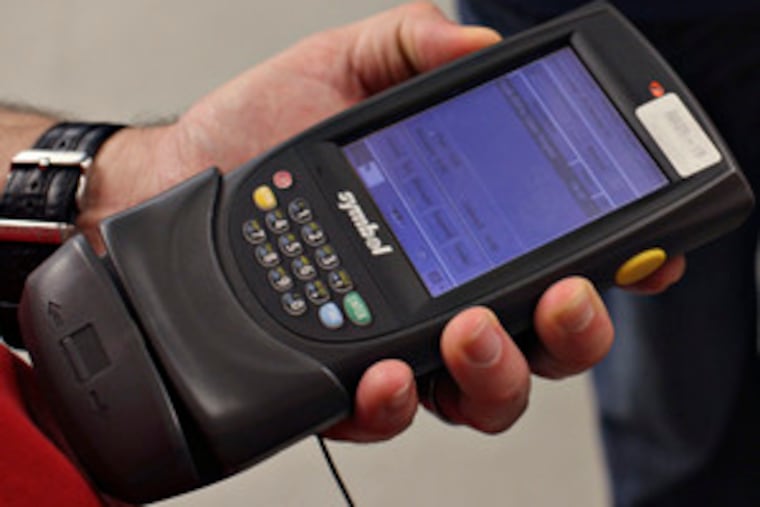Checking out ways to check out faster
U.S. retailers, confronting what may be the worst holiday-sales season in five years, are trying to get shoppers out of their stores.

U.S. retailers, confronting what may be the worst holiday-sales season in five years, are trying to get shoppers out of their stores.
Out, that is, after they've selected their purchases. Some examples:
The FAO Schwarz toy store in New York increased the number of transactions checkout clerks must make each hour.
Circuit City Stores Inc. says customers can pick up purchases in stores 24 minutes after ordering on-line.
And in one of the more innovative solutions, employees of Apple Inc.'s 178 U.S. shops prowl the floor with hand-held devices to complete sales and e-mail receipts. In the Philadelphia area, Apple has stores in Ardmore, King of Prussia and Marlton.
For what is expected to be the busiest holiday shopping weekend, retail chains are trying to get customers in the door with the lure of a quick checkout. The shorter the wait time, the greater the likelihood clients will return to a store, according to a survey by the Mystery Shopping Providers Association, a Dallas trade group.
"I saw the queues," said Tina Archer, a tourist from London, in the Apple outlet on Fifth Avenue in New York. "When I found I didn't have to stand in them, I thought, 'Great.' "
The speed of the roving checkout clerk "definitely would make me come back and shop," she said.
Surveys show that consumers are completing their holiday gift-buying later this year than in the last three seasons at least, said Michael Niemira, chief economist of the International Council of Shopping Centers.
"Competition is increasing, and speeding checkout is a way of distinguishing yourself," said Jane Hali, an analyst at Coleman Research Group in New York.
As many as 30,000 customers enter FAO Schwarz's Manhattan store each day, said Ed Schmults, chief executive officer of the toy seller's parent company, FAO Inc. Spokeswoman Nanette DiFalco said the average number of transactions expected from clerks each hour was increased this year from 2006. She declined to disclose the number.
"You don't want to have angry customers, for whom the last part of their experience in your store involves feelings of exasperation," Schmults said in an interview.
Best Buy Co., the nation's largest consumer-electronics retailer, reassigned 30 percent of its 90,000 sales staff in October as customer assistants. They are trained across broad product categories, such as home theater and gaming, to complement the specialist "BlueShirts" at the company's 917 locations, spokesman Brian Lucas said. Best Buy says it has cut its checkout times 20 percent in the last two years.
Non-technology retailers are going digital to speed customer traffic.
Coach Inc., the larget U.S. maker of luxury leather goods, started in-store pick-up for Web orders in July. Coach more than doubled to 98 the number of locations where clerks use "E-Runner" handheld-devices to transmit in-store orders to stockrooms, speeding checkouts. Coach also is shifting its most-efficient salespeople to work peak business hours.
Department stores also are improving their checkout times, according to an October survey by the Mystery Shopping Providers Association. The average wait-time for customers was 4 minutes and 39 seconds, down from 5 minutes and 23 seconds in the checkout line last year.
Saks Inc. was speediest among the 12 chains surveyed, with a wait time of 1 minute and 12 seconds. Privately held Lord & Taylor ranked last, with customers waiting 7 minutes and 42 seconds. Lord & Taylor spokeswoman Lavelle Olexa in New York didn't return phone calls seeking comment.
When asked what frustrates them about shopping during the holiday season, 52 percent cited long checkout lines in a survey of 1,020 consumers in October, according to NCR Corp.
"People are time-starved," said Michael Appel, a retail consultant at Quest Turnaround Advisors L.L.C. in Purchase, N.Y. "One of the things they want is to get in and out."